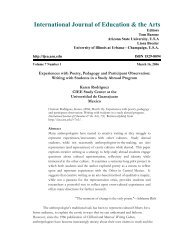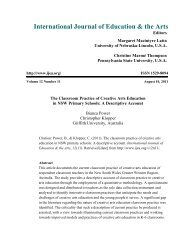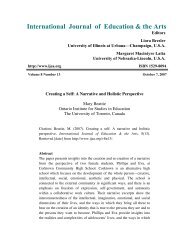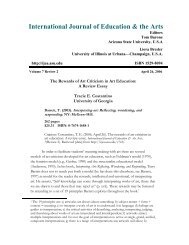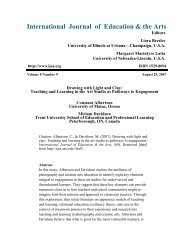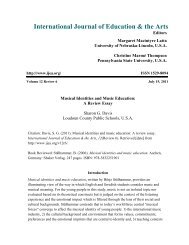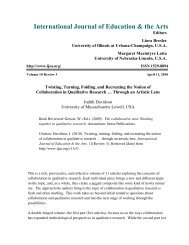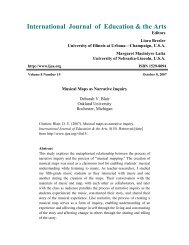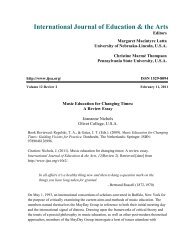On Empathy: The Mirror Neuron System and Art Education
On Empathy: The Mirror Neuron System and Art Education
On Empathy: The Mirror Neuron System and Art Education
Create successful ePaper yourself
Turn your PDF publications into a flip-book with our unique Google optimized e-Paper software.
IJEA Vol. 10 No. 15 - http://www.ijea.org/v10n15/ 8<br />
meaningful to us because we can share them with others” (Gallese, 2003, p. 176). <strong>Empathy</strong> is<br />
possible, playing a crucial role in social life <strong>and</strong> in allowing people “to share emotion,<br />
experiences, needs, <strong>and</strong> goals” (Iacoboni, 2008, p. 109). At the most fundamental level,<br />
empathy allows us to underst<strong>and</strong> facial expressions, gestures, intentions, feelings, language,<br />
<strong>and</strong> metaphor.<br />
Evidence of basic empathic underst<strong>and</strong>ings comes from those cognitive studies designed to<br />
investigate how facial expressions <strong>and</strong> the feelings they signify evoke responses in the<br />
observer. To study the feeling of disgust, for example, Heining, et al. (2003) scanned the<br />
brains of participants who observed the faces of actors portraying looks of disgust, happiness,<br />
<strong>and</strong> neutrality. <strong>The</strong>se participants were also scanned while inhaling a disgusting odor.<br />
Comparing the two scans, researchers found an activation of a region within the anterior<br />
insula, both when participants directly experienced the disgusting smell <strong>and</strong> observed the look<br />
of disgust. <strong>The</strong> look, as Gallese (2006) concludes, induces a “visceral motor somatosensoryrelated<br />
embodied simulation” of the feeling of disgust.<br />
In other research, Sonnby-Borgstrom (2003) <strong>and</strong> Dinberg (1982) found that participants’<br />
facial muscles were activated in keeping with the emotions they observed on the faces of<br />
others. For example, the activity of cheek muscles used for smiling increased among<br />
participants when observing happy faces, as did the activity of brow muscles used for<br />
frowning when observing angry faces (Dinberg, 1982). <strong>The</strong>se results suggest a kind of “motor<br />
mimicry” that, according to Iacoboni (2008), aids perception <strong>and</strong> non-verbal communication<br />
(pp. 110-11). In addition, the Sonnby-Borgstrom (2003) study further demonstrated that the<br />
degree to which facial muscles were activated correlated positively with the participants’<br />
scores on an empathy inventory questionnaire; that is, the higher the scores, the more muscle<br />
activation, <strong>and</strong> ostensibly, the greater the capacity for empathy. <strong>The</strong>se <strong>and</strong> other results<br />
prompt Gallese (2003) to propose that “sensations <strong>and</strong> emotions displayed by others can also<br />
be ‘empathized,’ <strong>and</strong> therefore implicitly understood, through a mirror matching mechanism”<br />
(p. 176).<br />
It seems likely that similar results would be obtained if participants were to observe artistic<br />
renderings of the human face. Though unconfirmed by empirical measures as yet, there is<br />
compelling, if anecdotal evidence suggesting that the faces of museum visitors resonate along<br />
with the facial expressions of exhibited portraits. Indeed, these artforms, or “artifacts,” as<br />
Danesi (1993) describes them, are a “means for evoking fundamental feelings <strong>and</strong> sensations”<br />
(p. 77). This appeared to be the case when visitors to the Getty Museum were caught up in an<br />
empathic-aesthetic experience of Bill Viola’s video art, Six Heads (2000), a key piece in his<br />
larger work, <strong>The</strong> Passions (2000-02). <strong>On</strong> a single screen, visitors found an actor’s face <strong>and</strong>




